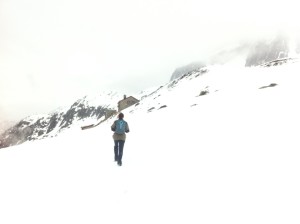My boyfriend and I went to Switzerland again for a holiday. The plan was to do some epic climbing, but it rained almost every day while we were there. Because we couldn’t climb, we did a lot of epic walking (and running) instead… which gave me a lot of time to think. Some of the themes started repeating themselves, so I recorded them, and then thought about how I could apply them to remote working.
Take little steps in the direction that you want to go
We walked down some seriously daunting paths! When I was tired, I took smaller steps and I gave myself the luxury of moving slowly to enjoy the journey as much as possible.
When a company is starting to allow their employees to work remotely, it’s good to just take small steps. Maybe start by allowing everyone to work at home one day per week. Or discuss together what the standards will be while working remotely.
At one company, we all agreed to keep our Skype status accurate with our taglines updated with what we were working on or where we were. Use agile best practices to be more transparent in your work.
Practice on the little things so you can be ready for the bigger adventures
On every trip to the mountains, I’ve had to cross a wide, fast-running stream where the bridge was out, or the stream was just bigger than usual. On the easier trails, I practiced balancing on and jumping over rocks. Doing this, I could figure out what my limits were before having to jump across a raging river.
Make sure that you have good communication practices in place before you being working remotely. If poor communication is already an issue at your office, working remotely will only amplify the problems.
Don’t forget to look up every once in a while and enjoy the view
While walking, I would find myself entirely focused on getting to our next destination, until my boyfriend would point out things that I was missing: small avalanches on other mountainsides, or well-camoflauged animals who were sunbathing in the hills.
Remote workers can feel especially disconnected and focused on their own worlds. it’s important to “look up” and acknowledge contributions and accomplishments.
There are a few things I’ve seen work well: One remote employee joined their company’s holiday party via Skype. A company sent their remote staff gift certificates for a local restaurant in lieu of not being able to join the team dinner. My former colleagues and I started having regular “virtual lunches“, that continue to this day.
The path forward might not always be obvious, but a solution will usually appear
Sometimes, as I scanned the trail ahead of me, I couldn’t see how I was going to get across that snowfield, or cross that river, or find my next step. But with every hurdle, there was a way through it. Some solutions were harder than others, but everything had a solution. I learned to trust that I would know how to deal with a problem when it arose.
You won’t be able to anticipate all of the problems that you will run into when starting to work remotely. Internet connections go down, misunderstandings happen, and company culture can change in unexpected ways.
Facilitation from a good manager can motivate employees to give back. Employees who are engaged are more motivated to contribute and solve problems.
Know your limits and don’t be afraid to ask for help
My boyfriend has been wanting to do a glacier tour for a long time… but I have no experience on glaciers. And for me to feel comfortable, I knew I needed additional knowledge. We had the opportunity on this trip to take a glacier class – so we took advantage of it! And while I still need a lot more experience, I at least have an overview of what I need to know, and what my limits are.
Remote working is not for everyone. A lot of people I know do not like to work from home. They prefer the social aspect of working in the office. Conversely, another colleague of mine lives in a student house where it would be impossible to have planned hours when it is quiet.
It’s important that each employee knows what their personal limitations and preferences are.
I hope you’ve enjoyed the journey through my Swiss holiday adventure, and I hope it brought more insights to the world of remote working.
What are your tips for working remotely?



Very inspiring post! A rainy holiday can bring new experiences and insights obviously!
My remote working tip: Make sure there is enough chance to connect people in real life, preferably in fun activities, before relying on technologies to communicate when working remote. If this real life connection isn’t there, no technology, change management, culture or leadership program will get the collaboration going.
Thanks Petra! You’re right. Connecting in real life is important and irreplaceable.
I’ve been working with a team of people from California for the last couple of years (I’m in the Netherlands). Some colleagues I’ve still never met. To keep the human connection, we maintain regular contact via IM (saying good morning at the beginning of the day, etc) and start every meeting with a video chat so we can see each other. We also have regular “virtual lunches” together, which is really fun: http://www.flickr.com/search/?q=virtuallunch&w=72814000@N00&adv=1&mt=all&ct=6&m=tags
So while it’s not ideal, it works because we’re all committed to making it work – and we genuinely enjoy working with each other.